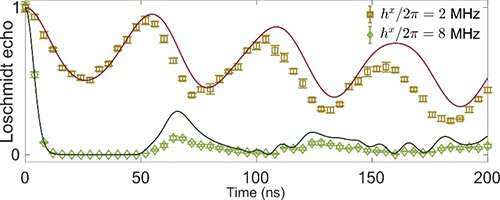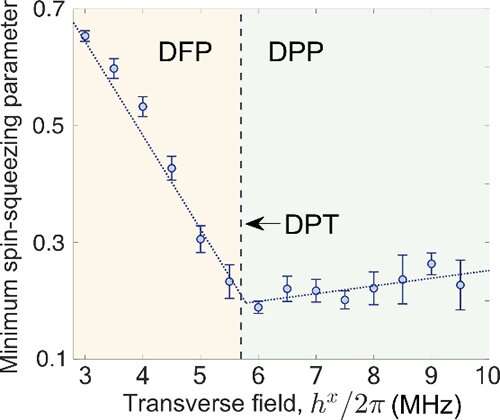Researchers perform quantum simulation of dynamical phase transitions

Quantum simulation uses a controllable quantum system to mimic complex systems or solve intractable problems, among which the non-equilibrium problems of quantum many-body systems have attracted wide research interest. Such systems are hard to simulate using classical computers. Instead, popular quantum simulators, such as superconducting circuits, can provide insights into these problems. As considerable advances have been made in scalability, coherence and controllability, superconducting circuits have become one of the most important quantum simulation platforms.
Recently, a research group from the Institute of Physics of the Chinese Academy of Sciences, Zhejiang University and RIKEN in Japan, has successfully performed quantum simulation of dynamical phase transitions in a Lipkin-Meshkov-Glick model with a 16-qubit superconducting quantum simulator.
Dynamical phase transition (DPT) is a kind of nonequilibrium phase transition and has been theoretically investigated in various quantum many-body models. There are two types of DPT. The first type (DPT-1) focuses on the non-equilibrium order parameter, while the second type (DPT-2) is characterized by the non-analytical behaviors of Loschmidt echo associated with the Lee-Yang-Fisher zeros in statistical mechanics. Further theoretical and numerical investigations have revealed that DPT-1 and DPT-2 can be studied in the same framework.
The quantum processor integrates 20 superconducting qubits all coupled to a common resonator bus, which was used to generate Schrödinger cat states in previous work. This time, 16 qubits were used to engineer the Lipkin-Meshkov-Glick (LMG) model by applying controllable transverse field to each qubit. The system is driven into a non-equilibrium state with microwaves and then evolved under the LMG model.

The researchers first observed typical features of the DPT-1. For the small transverse field, the system stays in the dynamical ferromagnetic phase (DFP), and the magnetization exhibits a slow relaxation. However, given a strong transverse field, the system enters into the dynamical paramagnetic phase (DPP), in which the magnetization exhibits a large oscillation at an early time and approaches zero in the long-time limit. The time-averaged magnetization as the non-equilibrium order parameter is zero in the DPP, while it becomes finite in the DFP.
Then they demonstrated the existence of the zeros of Loschmidt echo in the DPP, suggesting the relation between DPT-1 and DPT-2. In addition, the researchers explored the DPTs from a novel perspective. They studied the minimum spin squeezing as a probe of the phase transition.

The experimental results show that the minimum value of the spin-squeezing parameters can be achieved very close to the critical point of the DPT. This indicates a potential application of the DPT to quantum metrology.
This study, titled "Probing dynamical phase transitions with a superconducting quantum simulator," was published in Science Advances.
More information: Kai Xu et al. Probing dynamical phase transitions with a superconducting quantum simulator, Science Advances (2020). DOI: 10.1126/sciadv.aba4935
Journal information: Science Advances
Provided by Chinese Academy of Sciences





















